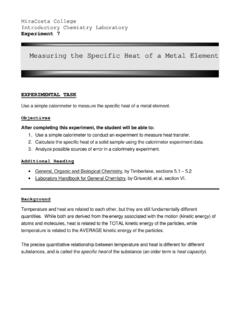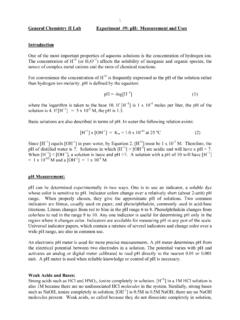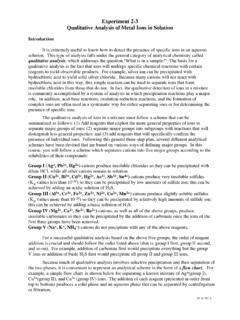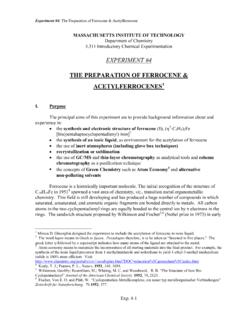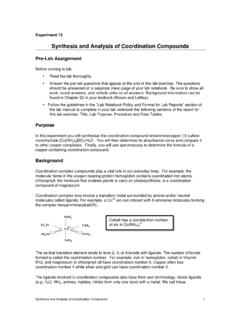Transcription of Determination of an Equilibrium Constant
1 Determination of an Equilibrium Constant Minneapolis Community and Technical College Principles of chemistry II, C1152 I. Introduction Equilibrium Consider the following situation: It is rush hour and cars are entering the I-94 freeway at a rate of 30 cars per second. Obviously, if this were the only thing affecting traffic, congestion would build and soon all cars would be at a stand still. However, cars also leave the freeway and this reduces the total number of automobiles. These two processes, cars leaving and entering, determine the overall number of automobiles on the roadway.
2 The term Equilibrium applies when the rates of both processes are equal. For example, if cars enter the freeway at 30 cars/second and leave the freeway at 30 cars/second, the total number of cars on the freeway never changes and we have a state of Equilibrium . Traffic control engineers work to regulate traffic on and off of a freeway as they attempt to achieve a situation that reduces the average commute time for everyone. Chemical Equilibrium exists when the rate of the forward reaction converting reactants to products is equal to the rate of the reverse reaction which converts products into reactants.
3 At Equilibrium : Rateforward rxn = Ratereverse rxn Once chemical Equilibrium has been established, the levels of products and reactants remain Constant . Thus, if the system is in Equilibrium , no further changes will be observed. Note however that on a molecular/atomic scale, both forward and reverse reactions still occur. Now, consider the following general chemical equation: x X + y Y + z Z a A + b B + c C The double arrow ( ) indicates that both forward and reverse reactions occur and that this is a chemical Equilibrium situation.
4 The lower case letters are the coefficients in the balanced chemical equation and the upper case letters identify the product and reactant species. Because Equilibrium concentrations of products and reactants don t change, their ratio is Constant : This Constant is known as the concentration based Equilibrium Constant Kc and is calculated using Equilibrium concentrations of reactants and products. These molar concentration values for each species appear in brackets raised to an exponent that is the coefficient from the balanced chemical equation.
5 This value of Kc remains Constant from trial to trial as long as the temperature is Constant . The Fe3+(aq) ,SCN-(aq) and FeSCN2+(aq) Equilibrium In this experiment, we will study the reaction of Fe3+(aq) and SCN-(aq) ions and the product they form; deep red/orange-colored FeSCN2+(aq) complex ions: Colorless Colorless Orange Fe3+(aq) + SCN-(aq) FeSCN2+(aq) Iron(III) Thiocyanate Thiocyanoiron (III) The final Equilibrium concentrations of products and reactants depend on the initial amounts of reactants before the reaction occurs.
6 However, regardless of the initial concentrations, the final Equilibrium concentrations must satisfy the following relationship: [FeSCN2+]eq Kc = -------------------------- (Equation 1) [Fe3+]eq [SCN-]eq whereas described previously, brackets denote Equilibrium molar concentrations of products & reactants. Our goal in this experiment is to determine the Equilibrium Constant , Kc. To do so, we ll need Equilibrium concentrations we can substitute into the equation above.
7 Because the FeSCN+2 is the only colored species (red/orange), its Equilibrium concentration can be measured directly using the LoggerPro colorimeter. The Equilibrium concentrations of the reactants Fe3+ and SCN- can be then determined by subtracting the product amounts from the initial reactant concentrations Six reaction mixtures with different initial reactant amounts will be analyzed at Constant temperature to verify Kc values are Constant . Ideally, Kc would be the same in all trials as long as the temperature doesn t change.
8 Additionally, three trials will be performed at lower temperatures to determine the effect on Kc. Remember that since Kc is the product to reactant ratio, an increase in Kc means there are more products and less reactants. Conversely, a decrease in Kc means there are fewer products and more reactants in the Equilibrium mixture. Equilibrium : The method The method used to solve Equilibrium problems is referred to as which is an abbreviation for Initial, Change and Equlibrium: 1. Initial concentrations: pre- Equilibrium concentrations of all reactants and products a.
9 Usually require dilution calculations and are not bottle label concentrations b. Solids and liquids are not included in this step as their molar concentrations are Constant . 2. Change: The changes to the initial concentrations that are required to reach Equilibrium . a. Includes a variable X b. Uses stoichiometric coefficients from the balanced chemical equation c. - denotes decreases and + denotes increases d. May require a Q vs. Kc comparison to determine the direction of the Equilibrium change.
10 3. Equilibrium : The new concentration levels reached after Equilibrium is reached. The application of the method to this experiment s Equilibrium is diagramed below. Application of the dilution equation M1V1 = M2V2 is required to calculate the initial concentrations of Fe3+ and SCN- for each of the six trials. Initially we assume there is no product present. The initial product and reactant concentrations for Trial #1 are shown below. You will be asked to verify these results for Trial #1 and determine the initial concentrations for the remaining five trials as a prelab exercise.
